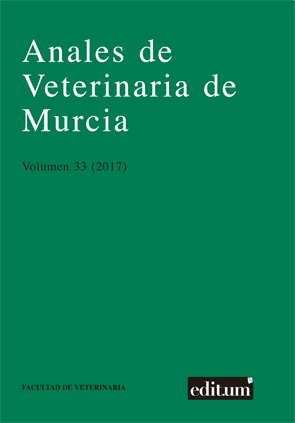Present and future of a new rodenticide within the European Union
Bromethalin
Abstract
In the broad field of rodenticides, Bromethalin is a molecule quite unknown in the European Union. However, it is very common and known to American veterinary professionals. With high toxicity (since it has been designed to be effective at a single dose), it generates both primary and secondary intoxications in animals, which the veterinarian must be able to identify, in order to establish an effective therapy as quickly as possible. In this sense, the clinical symptoms depend on the dose ingested, varying from an eminently stimulant form to a mainly depressive one. Although this molecule is still banned in the majority of the European Union, the recent restrictions on anticoagulant rodenticides may foster the authorization of Bromethalin. Therefore, this article reviews this substance, with special emphasis on its mechanism of action and the symptoms it causes, providing current data that may be useful for the clinical veterinarian.
Downloads
References
BATES M.C., ROADY P., LEHNER A.F., BUCHWEITZ J.P., HEGGEM-PERRY B., LEZMI S. 2015. Atypical bromethalin intoxication in a dog: pathologic features and identification of an isomeric breakdown product. BMC Vet. Res. 11: 244.
BAUTISTA A.C., WOODS L.W., FILIGENZI M.S., PUSCHNER B. 2014. Bromethalin poisoning in a raccoon (Procyon lotor): diagnostic considerations and relevance to nontarget wildlife. J. Vet. Diagn. Invest. 26(1): 154-157.
COPPOCK R. 2013. Advisory: Bromethalin rodenticide - No known antidote. Can. Vet. J. 54(6): 557-558.
COWAN V., BLAKLEY B. 2016. Characterizing 1341 cases of veterinary toxicoses confirmed in western Canada: A 16-year retrospective study. Can. Vet. J. 57(1): 53-58.
DECLEMENTI C., SOBCZAK B.R. 2012. Common rodenticide toxicoses in small animals. Vet. Clin. North Am. Small Anim. Pract. 42(2): 349-360.
DORMAN D.C., ZACHARY J.F., BUCK W.B. 1992. Neuropathologic findings of bromethalin toxicosis in the cat. Vet. Pathol. 29(2): 139-144.
DUNAYER E. 2003. Bromethalin: The other rodenticide. Vet. Med. 732-736.
EUROPEAN COMMISSION 2017. EU Pesticides Database. Disponible en: http://ec.europa.eu/food/plant/pesticides/eu-pesticides-database/public/?event=homepage&language=EN
FILIGENZI M.S., BUTISTA A.C., ASTON L.S., POPPENGA R.H. 2015. Method for the detection of desmethylbromethalin in animal tissue samples for the determination of bromethalin exposure. J. Agric. Food Chem. 63(21): 5146-5151.
GARCÍA-FERNÁNDEZ A.J., NAVAS I.M. 2014. Bromethalin. En: Encyclopedia of Toxicology 3rd ed, pp. 552-555. Ed. Wexler P. Academic Press, USA.
GUPTA R.C. 2012. Non-anticoagulant rodenticides. En: Veterinary Toxicology. Basic and Clinical principles. 2nd ed, pp. 698-711. Ed. Gupta R.C. Academic Press, Boston MA.
HEGGEM-PERRY B., MCMICHAEL M., O’BRIEN M., MORAN C. 2016. Intravenous lipid emulsion therapy for Bromethalin toxicity in a dog. J. Am. Anim. Hosp. Assoc. 52(4): 265-268.
HUNTINGTON S., FENIK Y., VOHRA R., GELLER R.J. 2016. Human bromethalin exposures reported to a U.S. Statewide Poison Control System. Clin. Toxicol. (Phila) 54(3): 277-281.
MCLEAN M.K., HANSEN S.R. 2012. An overview of trends in animal poisoning cases in the United States: 2002-2010. Vet. Clin. North Am. Small Anim. Pract. 42(2): 219-228.
PETERSON M.E. 2013. Bromethalin. Top Companion Anim. Med. 28(1): 21-23.
P.M.I.S. (Pest Management Information Service). 2013. New use restrictions for commercial class rodenticides in agricultural settings. Ed Health Canada. Disponible en: http://www.hc-sc.gc.ca/cps-spc/pubs/pest/_factfiche/restriction-rodenticides/index-eng.php.
REGLAMENTO (CE) nº 1272/2008 del Parlamento Europeo y del Consejo, sobre clasificación, etiquetado y envasado de sustancias y mezclas.
REGLAMENTO (UE) 2016/1179 de la Comisión, de 19 de julio de 2016, que modifica, a efectos de su adaptación al progreso científico y técnico, el Reglamento (CE) n.o 1272/2008 del Parlamento Europeo y del Consejo, sobre clasificación, etiquetado y envasado de sustancias y mezclas.
RUBINSTEIN I, WEINBERG G. 2014. Antidote for bromethalin poisoning. Can. Vet. J. 55(1): 1185.
U.S.E.P.A. 1998. Reregistration Eligibility Decision (RED) Rodenticide Cluster. Document EPA-738-F-98-004.
VAN LIER R.B., CHERRY L.D. 1988. The toxicity and mechanism of action of bromethalin: a new single-feeding rodenticide. Fundam. Appl. Toxicol. 11(4): 664-672.
Creative Commons Attribution 4.0
The works published in this journal are subject to the following terms:
1. The Publications Service of the University of Murcia (the publisher) retains the property rights (copyright) of published works, and encourages and enables the reuse of the same under the license specified in paragraph 2.
© Servicio de Publicaciones, Universidad de Murcia, 2019
2. The works are published in the online edition of the journal under a Creative Commons Attribution-NonCommercial 4.0 (legal text). You can copy, use, distribute, transmit and publicly display, provided that: i) you cite the author and the original source of publication (journal, editorial and URL of the work), ii) are not used for commercial purposes, iii ) mentions the existence and specifications of this license.

This work is licensed under a Creative Commons Attribution-NonCommercial-NoDerivatives 4.0 International License.
3. Conditions of self-archiving. Is allowed and encouraged the authors to disseminate electronically pre-print versions (version before being evaluated and sent to the journal) and / or post-print (version reviewed and accepted for publication) of their works before publication, as it encourages its earliest circulation and diffusion and thus a possible increase in its citation and scope between the academic community. RoMEO Color: Green.




